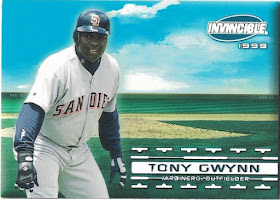Happy New Year's Eve!
I had a surprise at Christmas. Unbeknownst to me, my wife Cathy had arranged for my Mum to buy me a new scanner that I had idly added to my wishlist because I was curious to see if I could get better scans of foil cards than could be delivered by my trusty old flatbed scanner.
The new scanner is an 'overhead' scanner with built in LEDs. It looks like this:
I had a couple of foil Pinnacle cards, which really are the pinnacle of unscannable cards, lingering in my folders, so I decided to have a go with the new scanner to see if I could get better images of them.
Card Number 559: Pinnacle Naturals, 1998; #192
This was the flatbed scan. It's terrible.
This is the overhead scanner scan. Much better!
And this is the back, which I did on the flatbed.
The reference to a career power peak in 1997 is referring to Tony's career high for home runs (17) and RBI (119 - the only time he broke 100 ribbys).
Card Number 560: Pinnacle Plus, 1998; #83
Here's the flatbed scan.
Here's the (wonky) overhead scan.
And here's the cardback. The photo shows him fist-bumping another team-mate behind Steve Finley's back. It's an odd photo composition.
Overall I think the new scanner has worked for the foil cards. They still look a bit odd, and I need to work on my alignment for the scans. But they are heaps better than the flatbed versions - at least you can see the design even if the colouring is a bit off.
I went back and had a go with a couple of other cards to see if the new scanner worked better with them. I chose some cards from the Fleer/Skybox binder. These were both cards that were an utter nightmare to scan.
First up, the Metal Universe card from 1998. The original flatbed scan is on the left.
And then the MLPD card from the Metal Universe range in 1999 (that merited it's own
"scanning nightmares" post) - again the original scan is on the left.
The new scanner definitely captures more of the card, even if it's a little bit grainy. I can probably play around with the settings to improve the definition.
I also thought it would be fun to see how it captured an ordinary non-foiled card. I picked a DonRuss card at random.
It captured this card very well. Another feature with the scanner is that you can set it up on a timer to keep taking photos of the cards. This should make it easier to scan a stack of cards in one go because I don't have to keep opening the lid of the scanner, or even press any buttons to capture the image.
The only thing I have found is that I underestimated how much time I needed to flip the card over and line it up so it was reasonably straight. Oops, finger scan!
But then all I had to do was wait a few more seconds and it scanned for me again.
All in all, I'm very happy with my Christmas present. I'd like to give a shout out to my Mum for buying it for me, and to Cathy for helping my Mum choose it!
Maybe when I run out of new cards to blog, I will go back through and try and get some better scans of the nightmare foil cards I've already featured.
Total: 560 cards























































